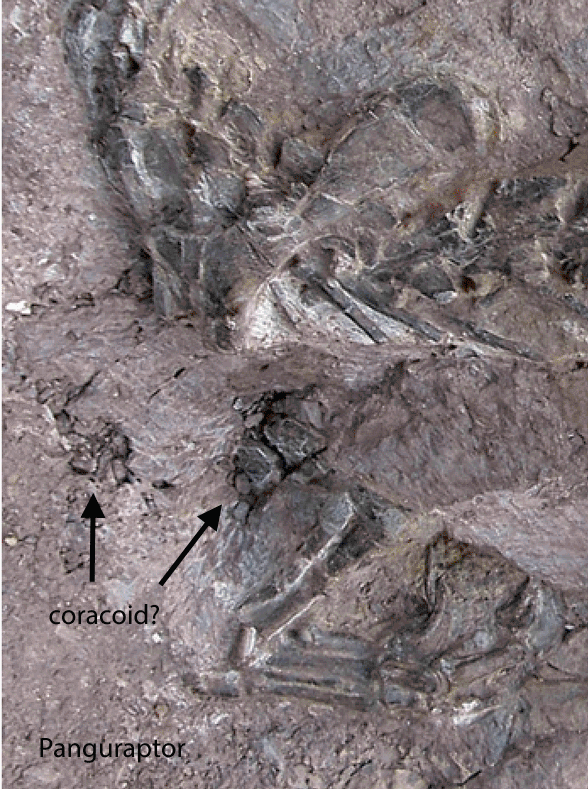Protoavis texensis
(Chatterjee 1991a,b; Norian, Late Triassic, 210 mya) has been an enigma taxon for thirty years. Two completely disarticulated and incomplete Protoavis skeletons were combined and reconstructed by Chatterjee (Fig. 1), who thought he had discovered a Late Triassic bird ancestor with a deep furcula, as seen in derived volant birds.
As everyone said at the time, this preceded Solnhofen birds with a shallow furcula, like Archaeopteryx, by 50 million years. A deep furcula evolved thereafter in Cretaceous birds. That Protoavis had such an anachronistic trait seemed untenable to most paleontologists at the time. The relatively unspecialized and unfused manus of Protoavis also argued against flight and a direct relationship to birds.
However
Chatterjee identified an elongate and locked down coracoid (Fig. 2) and it seems to be one. That only means Protoavis was flapping, but not flying in the Triassic, alongside flapping and flying pterosaurs with similar locked-down elongate coracoids. The precocial appearance of an elongate coracoid in Protoavis would be convergent, not homologous, with later flapping theropods, according to the LRT (subset Fig. 3). More on this coracoid below.

Protoavis inspired many headlines back in the early 1990s,
but has been relegated to the enigma cabinet ever since. That made it all the more interesting. When Protoavis was added to the large reptile tree (LRT, 1999 taxa; subset Fig. 3), it nested with an Early Jurassic theropod unknown in 1991: Panguraptor. That misidentified ‘furcula’ of Protoavis turns out to be distal pubis (Fig. 1) at present.
Panguraptor lufengenssis
(You et al. 2014; Early Jurassic; LFGT-0103; est. 2m in length) was a basal theropod that nested with Zuolong in LRT. Panguraptor and Protoavis share a retroverted pubis convergent with later theropods with this trait, including birds, microraptorids, dromaeosaurids, and therizinosaurids. The Panguraptor forelimb (Fig. 1) was relatively shorter than in the earlier Protoavis. The hind limb was more robust. The metatarsus was longer.
The Panguraptor coracoid
was not identified, considered lost. A few crumbled and scattered bones mark its original location. When reassembled to match (willfully forcing a match) Protoavis, the elements fit. This is not proof. This only represents possibility. This is also how the loose Protoavis scapula was flipped (Fig. 2) to match the shape of the scapula of Panguraptor, a taxon Chatterjee was not able to see before 2014. That’s a more natural match.

Comparisons to
Panguraptor document a long list of shared traits in Protoavis, including an odd small pelvis, with a laterally spreading anterior ilium, notched acetabulum and slightly retroverted pubes. The metatarsus was short, as in Tawa. The torso was relatively long compared to the femur and shallow compared to Tawa. The premaxillary teeth were small relative to the maxillary teeth.
Chatterjee’s controversial 1991 reconstruction
built from scattered pieces of two specimens (one larger than the other) is essentially correct, except for the mistaken identification of the distal pubes as a deep furcula. Chatterjee was handicapped by a lack of known comparable taxa back in 1991. It took the 2014 discovery of a sister taxon, Panguraptor with long list of similar traits, especially in the pelvis, to finally nest Protoavis after thirty years of mystery and relegation.
On a similar historic note and more recently,
Falcatakely was a basal theropod also mistaken for a bird due to taxon exclusion. So mistakes due to taxon exclusion continue to happen.
The nesting of Protoavis with Panguraptor appears to be a novel hypothesis
of interrelationships. If not, please provide a citation so I can promote it here.
References
Chatterjee S 1991a. Cranial anatomy and relationships of a new Triassic bird from Texas. Philosophical Transactions of the Royal Society B: Biological Sciences 332: 277-342.
Chatterjee S 1991b. Protoavis and the early evolution of birds. Philosophical Transactions: Biological Sciences 332(1265):277–342. PDF
You H-L et al. (4 co-authors) 2014. The first well-preserved coelophysoid theropod dinosaur from Asia. Zootaxa. 3873 (3): 233–249.nces 332: 277-342.



It’s not two skeletons, it’s two jumbles of fossils Chatterjee thinks are two specimens.
Chatterjee (1995) describes these Protoavis specimens in addition to the description of the skeletons referred to TTU P 9200 and TTU P 9201. They are:
(TTU P 9350-9355) six dorsal vertebrae (6-10 mm)
(TTU P 9356-9359) four caudal vertebrae (8-9 mm)
(TTU P 9360) coracoid(?) (14 mm)
(TTU P 9361) sternum(?) (25 mm)
(TTU P 9362) humerus (~80 mm)
(TTU P 9263) humerus
(TTU P 9364) partial mandible
(TTU P 9365) humerus
(TTU P 9370) femur (~58 mm)
(TTU P 9372) femur
(TTU P 9373) femur
(TTU P 9374) tibia
(TTU P 9375-9380) phalanges
(From Wikipedia)